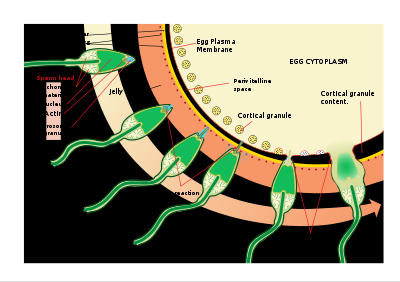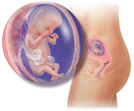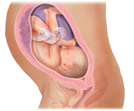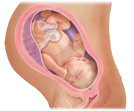Introduction
Background of the study
Fertilization is the initial stage of human reproduction or procreation which involves the fusion of a female’s ovum or egg with the male’s sperm in the ampulla of the uterus (Cummings, 2009, p.165). The union occurs when a male and a female engage in sexual intercourse whereby during ejaculation, the sperms in the vagina travel through the cervix into the uterus and finally into the oviduct/fallopian tube. The whole process occurs within thirty minutes after the sperms are introduced into the vagina. Apart from ejaculation during sexual intercourse, the sperms can be introduced into the vagina through artificial insemination or the process of in-vitro fertilization; the union between the egg and the sperm cell can be initiated artificially (Cummings, 2009, p.165). The process through which the sperm cells move from the vagina to the oviduct also referred to as swimming is aided by the whip-like contractions of the tail of the sperm cells and the vigorous contraction of the muscular female uterine walls.
When the sperm cell encounters a mature egg, it releases enzymes found in the Acrosome which digest the outer layer of the ovum thereby allowing the sperm plasma to sail through and fuse with the ovum’s plasma membrane. This is followed by the disconnection of the sperm head from the rest of the sperm cell after which the fertilized egg moves from the oviduct into the uterus.

It is evident from the diagram above that only one sperm cell can cross the outer layer of the ovum and fertilize a mature egg. The other sperm cells aid in the chemical changes that occur on the outer layer of the egg that eventually block the entry of additional sperm cells. The subsequent processes after fertilization include implantation followed by fetal development or pregnancy and finally childbirth or parturition.
Aim
The report is aimed at outlining the processes involved in human reproduction starting from fertilization through implantation, pregnancy, and finally to childbirth.
Scope
The report entails a detailed insight into the process of fertilization, particularly the processes that occur before fertilization such as sperm capacitation and acrosome reaction. It also documents the process of hormonal release that occurs before implantation. The three trimesters of pregnancy are also discussed in detail. Finally, the report provides an account of all three stages of childbirth.
Human Reproduction
Fertilization
Fertilization entails the fusion of an egg and the sperm cell. However, fertilization in itself entails a chain of episodes whose interruption leads to the failure of the whole process. The process begins with changes in the sperm cell which prepare it for additional processes. Thus the process of fertilization entails sperm capacitation, sperm-Zona Pellucida binding, the acrosome reaction, penetration of the Zona Pellucida, the egg activation and cortical reactions, and finally the Zona reaction (Bowen, 2000, p.1 of 3).
Before fertilization, the fresh sperm cells introduced in the vagina through the process of ejaculation undergo several chemical and structural changes referred to as capacitation. This is the process of removing the seminal components protecting the sperm cells followed by the rearrangement of the lipid and protein constituents of the plasma membrane of the sperm cells (Bowen, 2000, 0.1 of 3). The purpose of capacitation is to increase the motility characteristics of the cells besides destabilizing their plasma membranes in readiness for the subsequent reactions. The interaction of the sperm cell with the Zona Pellucida layer of the ovum is a species-specific reaction that can as well be regarded as binding of the ligand to its specific receptor site. Specific glycoproteins on the surface of the ovum have been shown to act as the sperm receptors whose function is to bind to specific proteins on the sperm cell membrane.
The sperm acrosome consists of Zona-digesting enzymes which play a major role in the acrosome reaction which enables the sperm to sail through the Zona Pellucida of the ovum. The protein receptors on the surface of the ovum take part in a series of reactions that provide the sites for the fusion of the outer layer of the Acrosome to the plasma membrane of the egg. This process leads to the formation of vesicles and seepage of the Acrosomal contents through the process of exocytosis from the sperm head. Progressive Acrosome reaction leads to loss of the Acrosomal contents until the whole sperm head moves through the Zona Pellucida. In case a sperm cell loses its Acrosomal contents before reaching the inner surface of the egg, it fails to fertilize it (Bowen, 2000, p.1 of 3).
Egg activation entails the metabolic and physical changes in the egg which follows the binding of the sperm cell to the egg. The egg is thus activated from its resting state mainly in the second meiotic allotment phase into a zygote (Cummings, 2009, p.166). Subsequent reactions which follow sperm-egg fusion entail hardening of the Zona Pellucida and destruction of the sperm receptors thereby excluding the entry of additional sperm cells into the fertilized egg (Bowen, 2000, p.1 of 3).
Hormonal Release during Implantation
The processes which lead to the formation and maturation of the ova are collectively referred to as the ovarian cycle. They also entail the formation of oocytes and grounding of the uterine wall in readiness for implantation. All these processes are controlled by hormones from the ovary, anterior pituitary, and hypothalamus. The Hypothalamus secretes the Gonadotropin-releasing hormone (GnRH) which acts on the anterior pituitary thus causing the production of the Follicle Stimulating Hormone (FSH) and the Luteinizing Hormone (LH) (Grudzinskas & Yovich, 1995).
FSH mediates the development of the ovarian follicles and the production of another hormone known as estrogen from the follicles. Further growth of the follicles is maintained by the LH which also mediates the full production of estrogen from the follicles. LH further initiates and maintains the formation of female eggs in the ovary and the growth of the Corpus luteum. It also promotes the secretion of estrogen and progesterone among other hormones of the corpus luteum. Besides inhibiting the secretion of GnRH, FSH, and LH from the Hypothalamus and the Anterior Pituitary, Estrogen promotes the development of female sex characteristics. Estrogen and Progesterone prepare the uterine wall in readiness for implantation. The two hormones also promote the growth of mammary glands for milk production. Another hormone, Relaxin produced by the Corpus luteum relaxes the contraction of the uterus thereby promoting implantation (Grudzinskas & Yovich, 1995).
The Three Trimesters of Pregnancy
Pregnancy or fetal development comprises the period between fertilization and childbirth. It is divisible into three stages also known as trimesters which can last up to 12-13 weeks each. These stages entail several rounds of mitosis within the 36-39 weeks of pregnancy involving the zygote that eventually leads to the development of tissues and organs in the fetus (Cummings, 2009, p.166). The first trimester takes 14 weeks during which period the fetus develops from being an embryo to having discrete webbed fingers. It also moves constantly and at the end of the trimester, it develops intact fingerprints and it measures about three inches as illustrated in the picture below.

The second trimester begins at the end of the 14 weeks and lasts up to the 7th month of pregnancy. During this stage, the fetus grows in length and puts on weight and at the end of this period; it weighs about 3 pounds and about measures about15 inches by length. Additionally, the skeleton changes from the cartilaginous bones to hard bone. The skin also smoothens as it begins to store fats. The eyes begin to open and close depending on the direction of light as shown below.

The third trimester starts immediately after the 7 months of pregnancy and lasts until childbirth. During this stage, the weight of the fetus increases to about 5-7 pounds and it can measure up to 19 inches when stretched. All the body organs are fully developed and the fat deposited in its body gives it a more rounded and smooth shape. As it can be seen in the diagram below, its head is facing the vaginal opening indicating that it is ready to be expelled. However, it should be noted that babies differ broadly at this point.

The Three Stages of Childbirth
Childbirth or parturition marks the end of the pregnancy during which period, one or more infants are expelled from the uterus. Normal human birth is divided into three stages which are preceded by six major phases of changes to the cervix. Pregnancy labor takes up to 12-24 hours for those women giving birth for the first time or shorter than this period for those who have had children (Gjerdingen & Froberg, 1991, p.29). The first stage or the dilation phase can last up to 20 hours. It begins when the cervix dilates up to 3 centimeters wide and widens further up to 10 centimeters during contraction of the uterine muscles.

The diagram above shows the various stages of dilation that follow the initial dilation coupled with the active muscular contraction of the uterine muscles.
The second stage or the expulsion phase begins after the cervix has dilated fully and lasts until when the baby is expelled from the uterus. The stage is characterized by increased pressure on the cervix followed by placement of the baby’s head in the pelvis. Assisted by the downward pushing mechanisms from the mother, the head goes past the pubic arc to the outside through the introitus. Further contractions expel the lower body from the uterus. The third stage of childbirth or the placenta stage involves the expulsion of the afterbirth from the uterus. Further loss of blood by the mother is controlled by the uterine contractions after the placenta is expelled (Gjerdingen & Froberg, 1991, p.35).
Conclusions
The report has provided an in-depth account of human reproduction. It provides discussions on the activities which are involved in fertilization and implantation of the mature and fertilized egg on the endometrial wall. In addition, the report gives the details regarding the hormonal release which precedes implantation. Further, the three stages of pregnancy and fetal development are analyzed in this report. Finally, the report describes all three stages of childbirth. From the above discussion, it can be concluded that fertilization is a very important stage in human procreation. It entails a series of stages that lead to the fusion of the sperm cell and the oocytes to form an embryo. The embryo is maintained in the uterus through the process of implantation which enables the fertilized egg to fuse with the endometrial wall. Further divisions of the embryo give rise to tissues and organs observable in a full-grown fetus. The fetus is finally expelled from the uterus through the process of parturition.
Reference list
Cummings, M. 2009. Human heredity: principles and issues (8th ed.), Yolanda Cossio Publishers, UK.
Bowen, R. 2000. Fertilization: fertilization and early embryonic development. Web.
Gjerdingen, DK & Froberg, D.G. 1991.The fourth stage of labor: the health of birth mothers and adoptive mothers at six-weeks postpartum. Fam Med. Vol. 23, no.1, pp. 29–35.
Grudzinskas, J.G. & Yovich, J (eds.) 1995. Gametes: The Oocyte. Cambridge: Cambridge University Press.